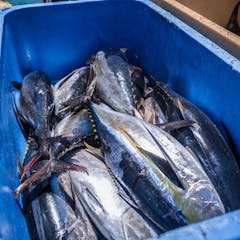
Articles on Overfishing
Displaying 1 - 20 of 116 articles

Long lifespans and slow reproduction rates make deep-water sharks and rays as vulnerable to overexploitation as whales once were. We must place them under protection to avoid extinctions.

The toll on wildlife from illegal fishing, bycatch and entanglement in fishing gear is likely underestimated, because it doesn’t account for ‘dark’ fishing vessels, a new study finds.

Recent research shows how reducing overfishing is both an ecological imperative and a critical means to addressing climate change.

Governments all over the world are propping up overfishing. Now scientists have penned an open letter calling on trade ministers to implement stricter regulations against harmful fisheries subsidies.

Over 200 million tonnes of sediment are transported by rivers to the sea each year, the most widespread water contaminant in the country. Its devastating impact on marine life has to be reversed.

A new initiative is pinpointing areas in the world’s oceans that are key habitats for sharks and their relatives, so that governments can consider protecting these areas.

Climate change and overfishing are depleting global fish stocks with clear implications for the food security future of billions of people.

Blood isn’t sterile, and analyzing the bacteria in it could help assess the health of fish and prevent the collapse of their populations.

Breeding tuna in captivity is a promising solution to overfishing, but there are concerns surrounding fish welfare.

Studying a guillemot colony for 50 years has provided unique insights into how climate change and oil spills affect seabird populations.

Some baby sharks eat their unborn siblings in utero, while others spend 100 years in childhood. Sink your teeth into the weird world of these juvenile wonders of the deep.

Through regulation, enforcement and monitoring, fisheries management can lead to recoveries in shark and ray populations.

Rhino rays, which are close relative of sharks, are some of the most fascinating – and most threatened – fishes that you’ve never heard of.

Having a flexible and adaptable management system is necessary to sustainably manage fisheries, especially in times of a rapidly changing climate.

Humans rely on the ocean for food, jobs and other resources, but these systems are being stressed to the brink.

When you buy seafood, you can’t be sure it is what it says it is – and Australian wholesalers are resistant to new traceability technologies.

Putting a dollar value on nature has staunch opponents who say it’s morally wrong, but without it, building dams and other infrastructure can run roughshod over vital ecosystems.

Over 100 shark and ray species were recently added to an international treaty, known as the CITES list, to protect them from the threat of unsustainable and illegal trade.

Countries have voted to limit the international shark trade, but this fails to account for the diversity in fishing contexts around the world.

A study offers evidence that marine biology’s biggest stage is broken, and suggests ways to fix it.
